Mikoyan-Gurevich MiM-31 (A,B) "Karyovin"
(Version 1.01 - Last updated:
06/21/03)
- Background and RPG stats by Kenneth
Olson
- Based off a design shown in Robotech Episode 33 "Rainy Night"
- Artwork from Wildstorm Source Book #1
BACKGROUND
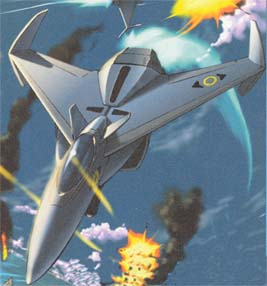 The Mikoyan Gurevich MiM-31 was designed in the early
1990's to replace both the Mig-29 air superiority fighter and the SU-39 ground
attack bomber. The resultant fighter incorporated a new delta wing design
with wing tipped veritech stabilizers and forward canard wings to provide
agility at all altitudes and produce a fighter which was capable of flying head
to head against any of the contemporary Western Alliance fighters, such as the
F-16, F/A-18, and the F-15. The initial flight of the MiM-31 occurred on
November 15 1991 and proved so successful that the Soviet Air Force ordered the
MiM-31 into full production the following month.
The Mikoyan Gurevich MiM-31 was designed in the early
1990's to replace both the Mig-29 air superiority fighter and the SU-39 ground
attack bomber. The resultant fighter incorporated a new delta wing design
with wing tipped veritech stabilizers and forward canard wings to provide
agility at all altitudes and produce a fighter which was capable of flying head
to head against any of the contemporary Western Alliance fighters, such as the
F-16, F/A-18, and the F-15. The initial flight of the MiM-31 occurred on
November 15 1991 and proved so successful that the Soviet Air Force ordered the
MiM-31 into full production the following month.
The aircraft was designed around the massive 35mm GSH-35
gatling gun mounted underneath the main fuselage. This weapon is capable
of punching through the armor of most tanks and provided the MiM-31 with
fearsome air-to-ground capabilities. In addition to the GSH-35 cannon, the
fighter is capable of mounting up to 8,400 kg of external ordinance, including
precision laser or TV guided weaponry. The fighters air-to-air capability
was provided by six wing hard points capable of mounting up to twelve short
range AA-11 "Archer" or six long range AA-12 "Adder" missiles.
With the opening shots of the Global Civil War in January
of 1992, the design team at Mikoyan Gurevich was pressured to bring the
production lines of the MiM-31 up to wartime capacity. The first combat
squadrons were formed in the summer of 1992 and immediately placed into combat.
The MiM-31 showed that it had no equal in its ground attack role, capable of
destroying entire units and possessing the speed to escape from any pursuit.
For the first couple of months of the global conflict the Karyovin, proved to
itself equal to all Western air superiority fighters; although, this parity was
short lived as the MiM-31 was outclassed with the introduction of the
F-203 Dragon II.
Nevertheless, the design was sufficiently successful that the MiM-31 was
produced in vast quantities, with almost 7,500 units produced in the Soviet
Union and Allied Eastern Co-Prosperity States during the Global Civil War.
After the crash of the SDF-1 and subsequent end of the
Global Civil War, the newly formed Eastern Block Soviet Independent States (EBSIS)
were able to acquire key technologies from the crash site. This allowed
EBSIS engineers provide the aircraft with advanced titanium alloys which
provided greater protection from enemy weaponry and also resulted in new
advanced turbojet designs with vastly improved fuel economy and thrust to weight
ratios over the older models. The newly designed MiM-31B entered into
production in 2010 and along with the
S-37 "Berkut" was to be the EBSIS's primary frontline fighter for the next
two decades.
For much of the First Robotech War, the MiM-31 saw little
combat action, as the EBSIS tried to stay out of the battle; however, the
bombardment of the Earth by Zentraedi forces in 2011 destroyed nearly 80% of the
entire EBSIS Air Force. Although EBSIS industry was shattered by the
bombardment, new models of the MiM-31 were rolling off the production lines
outside the Ural Mountains six months later. In the interim years between
the end of the First and beginning of the Second Robotech Wars, EBSIS provided
equipment to almost every unaligned state outside the United Earth Government in
addition to some malcontent Zentraedi groups. Although no MiM-31 are known
to have been used directly by the Zentraedi, several mercenary groups based in
the Merchant Republic of South America which fly MiM-31 are known to have been
hired by renegade Zentreaedi. These missions on several occasions pitted
the MiM-31 against VF-1 veritech fighters flown by the Robotech Defense Force (RDF),
an encounter which the MiM-31 rarely won unless the odds were greater than 4 to
1 against the VF-1.
By the beginning of the Second Robotech War, the EBSIS
airforce had 2,100 MiM-31 of all models. As during the First Robotech War,
during the conflict with the Robotech Masters EBSIS forces tried to stay on the
sidelines to save themselves for the battle with the Armies of the Southern
Cross (ASC) that they were sure to come at the war's conclusion. At the
war's conclusion in August of 2030, the ASC were in such a depleted state that
EBSIS had became the dominate power on the planet without a shot fired. On
1-March 2033 EBSIS forces crossed into Germany thus beginning the Second Global
Civil War. MiM-31's were among the first combat aircraft into United Earth
Government airspace. EBSIS forces quickly established air-superiority and
looked to lake over all of Europe; however their plans soon came undone,
when the Invid attacked on 15-March 2033 routing most of the EBSIS forces and
completely destroying all of their conventional aircraft.
RPG STATS
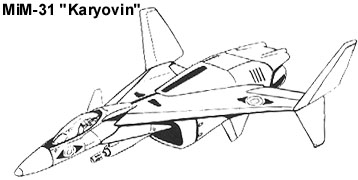 Vehicle Type:
MiM-31 "Karyovin"
Vehicle Type:
MiM-31 "Karyovin"- Class: Air superiority and strike aircraft
-
Manufacturer: Mikoyan-Gurevich OKB
Crew: One Pilot
- Service History:
-
MiM-31A: Single seat air superiority aircraft, served with the USSR from 1992-2010,
Eastern Co-Prosperity Sphere from 1992-2007, and later with the Eastern Block
Independent States from 2010-2031
- MiM-31B: Single seat air superiority aircraft, served with Eastern
Block Independent States from 2010-2031
-
MDC BY LOCATION:
| Location |
MiM-31 (A) |
MiM-31 (C) |
| 1 Pilot's Cockpit |
30 |
50 |
| 2 Rear Stabilizers (2) |
10 each |
25 each |
| 2 Wings (2) |
20 each |
50 each |
| Engines (2) |
20 each |
35 each |
| Ventral 35mm Cannon |
10 |
25 |
| 1 Main Body |
40 |
80 |
NOTES:
- Destroying the MDC of the main body or the Pilots Compartment will destroy the mecha
- Destruction of either of the wings or tails will send the Berkut into and uncontrollable spin
SPEEDS:
- MAXIMUM SPEED:
- MiM-21 (A): 1100 kph (Mach 0.9) at sea level and 1900 kph
(Mach 1.8) at 30 kft
- MiM-21 (B): 1300 kph (Mach 1.05) at sea level and 2200 kph (Mach
2.1) at 30 kft
- CRUISE SPEED (max performance without afterburner):
- MiM-21 (A): 1000 kph (Mach 0.94) at 30 kft
- MiM-21 (B): 1300 kph (Mach 1.22) at at 30 kft
- STALL SPEED:
- MiM-21 (A): 150 kph
- MiM-21 (B): 140 kph
- CLIMB RATE:
- MiM-21 (A): 19,000 meters per minute
- MiM-21 (B): 21,000 meters per minute
- CEILING:
- MiM-21 (A): 18,000 meters (60 kft)
- MiM-21 (B): 20,000 meters (65 kft)
- MIN TAKE-OFF DISTANCE:
- MiM-21 (A): 800 meters
- MiM-21 (B): 650 meters
- MIN LANDING DISTANCE:
- MiM-21 (A): 600 meters with drag chute
- MiM-21 (B): 550 meters with drag chute
- DESIGNED G LIMITS:
- +10.0 to -5.5 g
- RANGE:
-
- Nominal: MiM-21 (A) - 3,500 km, MiM (B) - 3,750 km
- Maximum: MiM-21 (A) - 4,150 km, MiM (B) - 4,500 km
- Ferry: MiM-21 (A) - 6,500 km, MiM (B) - 7,100 km
- Low Altitude: MiM-21 (A) - 1,050 km, MiM (B) - 1,250 km
STATISTICAL DATA:
- LENGTH:
- 16.5 m
- WINGSPAN:
- 10.2 m
- HEIGHT:
- 6.6 m
- WEIGHT (DRY):
-
- Dry: MiM-31(A) - 17,000 kg, MiM-31(B) - 18,250 kg
- Max Take-Off: MiM-31(A) - 27,000 kg, MiM-31(B) - 32,750 kg
- ENGINE THRUST
-
MiM-31 (A): 2 x Sarkisov RD-37
turbofan with thrust vectoring nozzles, 69 kN static thrust with 125 kN of
afterburner
- MiM-31 (B): 2 x Sarkisov RD-39 turbofan with thrust vectoring
nozzles, 90 kN static thrust with 157 kN of afterburner
- FUEL CAPACITY:
- MiM-31 (A): 1,250 US gal (4,732 liters)
- MiM-31 (B): 1,400 US gal (5,300 liters)
WEAPON SYSTEMS:
- (All) 1 x 35MM GSH-35-1 FOUR-BARRELED GATLING GUN: A single
35 mm cannon is mounted on the ventral side of the MiM-31. The cannon is
capable of firing up to 6,500 rounds per minute with a muzzle velocity in
excess of 1250 meters per second. The cannon is fed from an internal 800
round storage drum.
- PRIMARY PURPOSE: Anti-aircraft
- SECONDARY PURPOSE: Ground support
- RANGE: Accurate out to1500 m against moving targets
- DAMAGE: Armor Piercing (AP): 4D4 MDC short burst or 6D4 MDC medium burst. High Explosive Incendiary Tracer (HEI-T):
3D4 MDC short burst or 5D4 MDC medium burst
- RATE OF FIRE: Single shots or bursts equal to the combined attacks of the pilot.
- PAYLOAD: 800 rounds or 40 short bursts (20 rounds) or
20 medium (40 rounds)
- NOTES: HEI-T add +2 to strike, critical
strikes on conventional aircraft on 17-20
- (All) 6 x BODY/WING HARD POINTS: Up to lb (8,340 kg) of
external stores can be mounted on three hard points on either wing. Each
hard point can mount up to two short range missiles (such as the AA-8 or
AA-11), a single medium range or long range missile (such as the AA-10 or
AA-12), or up to 1,200 kg of fuel, equipment or ordinance
-
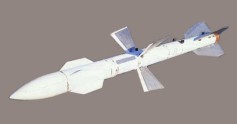 AA-10
ALAMO (R-27): The AA-10 "Alamo" was a contemporary of the American
Sparrow AIM-7M missile. The missile is equipped with a semi-active
radar homing head; although, several variants using passive IR and active RF
are known to exist. The AA-10 was used extensively by Russian and
Eastern Co-prosperity forces during the Global Civil War; however, the
missile was gradually phased out by the AA-12 in the early 21st century.
AA-10
ALAMO (R-27): The AA-10 "Alamo" was a contemporary of the American
Sparrow AIM-7M missile. The missile is equipped with a semi-active
radar homing head; although, several variants using passive IR and active RF
are known to exist. The AA-10 was used extensively by Russian and
Eastern Co-prosperity forces during the Global Civil War; however, the
missile was gradually phased out by the AA-12 in the early 21st century.
- PRIMARY PURPOSE: Anti-aircraft
- MISSILE SPEED: 3,000 kph
- RANGE: 80 km
- GUIDANCE: Semi-active radar
- DAMAGE: 2D6*10
- BLAST RADIUS: 40 feet
- RATE OF FIRE: One Missile
- STRIKE BONUS: +2 to strike
-
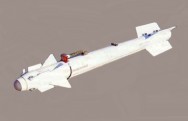 AA-11
ARCHER (R-73): The premier short range all-aspect IR missile
of the former Soviet Union, Eastern Co-Prosperity Sphere Forces and EBSIS.
The missile is directly connected to the pilot's helmet which allows
engagements lateral to the aircraft.
AA-11
ARCHER (R-73): The premier short range all-aspect IR missile
of the former Soviet Union, Eastern Co-Prosperity Sphere Forces and EBSIS.
The missile is directly connected to the pilot's helmet which allows
engagements lateral to the aircraft.
- PRIMARY PURPOSE: Anti-aircraft
- MISSILE SPEED: 2,000 kph
- RANGE: 40 km
- GUIDANCE: All aspect infrared
- DAMAGE: 1D6*10
- BLAST RADIUS: 30 feet
- RATE OF FIRE: One missile
- STRIKE BONUS: +3 to strike
- AA-12 ADDER (R-77): A Russian missile similar to the
American AIM-120 AMRAAM missile. The AA-12 is inertially guided to the
target from launch through mid-course and terminally guided by its own
onboard active RF seeker. The AA-12 missile was introduced during the
global civil war of the mid 1990's and became the premier medium range
missile for the Eastern-Co-Prosperity Sphere Forces.
- PRIMARY PURPOSE: Anti-aircraft
- MISSILE SPEED: 3,000 kph
- RANGE: 100 km
- GUIDANCE: Inertial with terminal active radar
- DAMAGE: 2D4*10
- BLAST RADIUS: 35 feet
- RATE OF FIRE: One missile or in volleys of two
- NOTES: +4 to strike
- 2 x CHAFF/FLARE DECOY DISPENSERS: Two chaff flare decoy dispensers
are located in the rear of the aircraft. Each dispenser can hold up to
30 decoys apiece with the standard load out consisting of 50% chaff
bundles and 50% flares. The type and number of each decoy is triggered
manually by the pilot.
- PRIMARY PURPOSE: Anti-missile
- RANGE: 100 m
- RATE OF FIRE: Up to 10 decoys per attack
- PAYLOAD: 30 decoys per dispenser
- NOTES: In game play only chaff bundles will
affect RF missiles and flares affect IR missiles. The player must
declare after the missile strike, without knowledge of the natural strike
roll of the missile attack, which type of decoy he is deploying.
For each effective decoy deployed subtract -3 from the natural die roll
for dumb missiles (those with strike rolls +2 or less), -2 from the
natural die from for standard missiles (+3 to strike), -1 from the natural
die roll from intelligent missiles (+4 or greater to strike). If the
natural die roll, with out any strike bonuses added falls below +5 then
the decoys are effective and the missile(s) will miss their intended
target.
STANDARD EQUIPMENT FOR THE KARYOVIN:
-
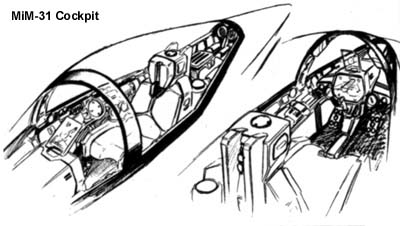 ACTIVE SENSOR JAMMER
SORBTSYS-S (L-006): Internal ECM providing broadband protection.
Estimated system effective radiative power 30 dBW.
ACTIVE SENSOR JAMMER
SORBTSYS-S (L-006): Internal ECM providing broadband protection.
Estimated system effective radiative power 30 dBW.
- AUTO-PILOT: The Karyovin is equipped with a computerized auto-pilot, allowing the
pilot to relax or even sleep during long voyages. The auto- pilot can be programmed with a
single destination or a complex flight plan involving multiple speeds, directions, and
destinations. The onboard computer will alert the pilot when the fighter is near its
destination, and can also be set to automatically signal when sensors detect objects near
the fighter.
- CHAFF AND FLARE DISPENSERS
APP-55: 30 chaff and 30 flares in two dispensers located in the rear
of the aircraft, see entry above for further details.
- COMBAT COMPUTER WITH HUD DISPLAYS: The combat computer tracks and identifies specific enemy
targets and displays them on a heads up display. The radar and combat
computer can identify and track up to 50 targets simultaneously and engage
with up to four semi-active missiles.
- INFRA-RED WARNING RECEIVER MIKOYAN IR-8 (IRWR):
Providing rear aspect protection from IR guided missiles
- LASER TARGETING SYSTEM: System has a range of 50 km and is
used to increase the accuracy of onboard weapons.
- RADAR ZHUK-29 X-BAND PULSE DOPPLER: Detection radar
against 0 dBsm target 80 km. The radar has limited multi-targeting
capability being able to track up to 50 targets but can engage only 4 at any
given time.
- RADIO/VIDEO COMMUNICATION: Long range, directional communications system with
satellite relay capabilities. Range: 300 miles (960 km) or can be boosted indefinitely via
satellite relay.
- RADAR-ABSORBING SKIN COVER: The Karyovin is covered with RF
absorbing material which reduces the aircrafts passive radar cross section.
- RADAR WARNING MIKOYAN YR-7 (RWR): Providing all
aspect broadband protection from RF guided missiles.
- STANDARD SURVIVAL KIT: All EBSIS fighters come equipped with a portable survival
kit. Inside the small reinforced box is a medium-sized flashlight, two hand flares, one
rocket flare, a compass, infrared distancing binoculars, a small mirror, a pocket knife,
dehydrated and concentrated food (can be stretched into a five day supply for one person)
and basic first aid items (aspirin, bandages, disinfectants, etc.)
- TACTICAL LIFE SUPPORT SYSTEM: The Karyovin's cockpit is pressurized, and also
provides additional air feeds to the pilot's flight suit that provides him with
pressurized breathing. The EBSIS flight suit also contains an upper and lower g-suit that
promotes blood circulation even during high-g turns, thus decreasing the possibility of
pilot's blacking out in combat.
COMBAT BONUSES FOR MiM-31 TRAINING:
- 2 actions per melee (plus those of the pilot)
- Add one additional action at levels six and eleven.
- +1 to strike with 20mm Cannons
- +5 to dodge
- +15% on all piloting skill checks.
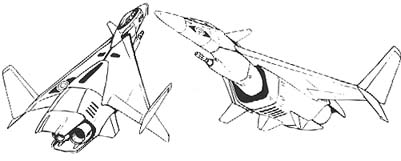 Random Hit Locations
Random Hit Locations
When there is an equal chance of hitting both sides from 1D6
- 1-3 hits the right side
- 4-6 hits the left
When there is a preferred side, roll 1D10
- 1-8 hits the preferred side
- 9-10 hits the opposite side
| MiM-31 |
FRONT |
BACK |
SIDES |
TOP |
BOTTOM |
| Pilot's Compartment (Main Body) |
01-35 |
01-05 |
01-20 |
01-20 |
01-15 |
| Rear Stabilizers (Wings) |
36-40 |
06-13 |
21-35 |
21-25 |
16-20 |
| Wings (Main Body) |
41-60 |
14-40 |
36-50 |
26-60 |
21-50 |
| Engines (Main Body) |
61-70 |
41-50 |
51-60 |
61-65 |
51-60 |
| 35mm Cannon (Main Body) |
71-80 |
51-60 |
61-75 |
- |
61-80 |
| Main Body |
81-00 |
61-00 |
76-00 |
66-00 |
81-00 |
REFERENCES USED IN THIS DESIGN
- Periscope: Mig-29 entry
- Macross: Perfect Memory:
MiM-31 "Karyovin" entry
- Robotech Technical Files: Mig-31 "Karyobin" / A-16 "Executioner"
entry
Back to Mecha Home
 The Mikoyan Gurevich MiM-31 was designed in the early
1990's to replace both the Mig-29 air superiority fighter and the SU-39 ground
attack bomber. The resultant fighter incorporated a new delta wing design
with wing tipped veritech stabilizers and forward canard wings to provide
agility at all altitudes and produce a fighter which was capable of flying head
to head against any of the contemporary Western Alliance fighters, such as the
F-16, F/A-18, and the F-15. The initial flight of the MiM-31 occurred on
November 15 1991 and proved so successful that the Soviet Air Force ordered the
MiM-31 into full production the following month.
The Mikoyan Gurevich MiM-31 was designed in the early
1990's to replace both the Mig-29 air superiority fighter and the SU-39 ground
attack bomber. The resultant fighter incorporated a new delta wing design
with wing tipped veritech stabilizers and forward canard wings to provide
agility at all altitudes and produce a fighter which was capable of flying head
to head against any of the contemporary Western Alliance fighters, such as the
F-16, F/A-18, and the F-15. The initial flight of the MiM-31 occurred on
November 15 1991 and proved so successful that the Soviet Air Force ordered the
MiM-31 into full production the following month. Vehicle Type:
MiM-31 "Karyovin"
Vehicle Type:
MiM-31 "Karyovin" AA-10
ALAMO (R-27): The AA-10 "Alamo" was a contemporary of the American
Sparrow AIM-7M missile. The missile is equipped with a semi-active
radar homing head; although, several variants using passive IR and active RF
are known to exist. The AA-10 was used extensively by Russian and
Eastern Co-prosperity forces during the Global Civil War; however, the
missile was gradually phased out by the AA-12 in the early 21st century.
AA-10
ALAMO (R-27): The AA-10 "Alamo" was a contemporary of the American
Sparrow AIM-7M missile. The missile is equipped with a semi-active
radar homing head; although, several variants using passive IR and active RF
are known to exist. The AA-10 was used extensively by Russian and
Eastern Co-prosperity forces during the Global Civil War; however, the
missile was gradually phased out by the AA-12 in the early 21st century.
 AA-11
ARCHER (R-73): The premier short range all-aspect IR missile
of the former Soviet Union, Eastern Co-Prosperity Sphere Forces and EBSIS.
The missile is directly connected to the pilot's helmet which allows
engagements lateral to the aircraft.
AA-11
ARCHER (R-73): The premier short range all-aspect IR missile
of the former Soviet Union, Eastern Co-Prosperity Sphere Forces and EBSIS.
The missile is directly connected to the pilot's helmet which allows
engagements lateral to the aircraft.
 ACTIVE SENSOR JAMMER
SORBTSYS-S (L-006): Internal ECM providing broadband protection.
Estimated system effective radiative power 30 dBW.
ACTIVE SENSOR JAMMER
SORBTSYS-S (L-006): Internal ECM providing broadband protection.
Estimated system effective radiative power 30 dBW. Random Hit Locations
Random Hit Locations